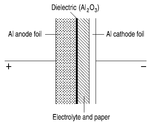boylesg
Advanced Member level 4
- Joined
- Jul 15, 2012
- Messages
- 1,023
- Helped
- 5
- Reputation
- 10
- Reaction score
- 6
- Trophy points
- 1,318
- Location
- Epping, Victoria, Australia
- Activity points
- 11,697
I did a little experiment with 25cm square bits of Al tape dipped in a salt solution - it gave me a capacitance of around 5-6 uF.
If I was to use 2 x roll of Al foil (30m x 30cm) to make an electrolytic capacitor with a salt solution soaked insulator between the sheets then I should end up with a capacitance of over 3000uF.
Now what would be the most appropriate porous insulator? Would paper towel withstand 200V? Does anyone know?
If I was to use 2 x roll of Al foil (30m x 30cm) to make an electrolytic capacitor with a salt solution soaked insulator between the sheets then I should end up with a capacitance of over 3000uF.
Now what would be the most appropriate porous insulator? Would paper towel withstand 200V? Does anyone know?
